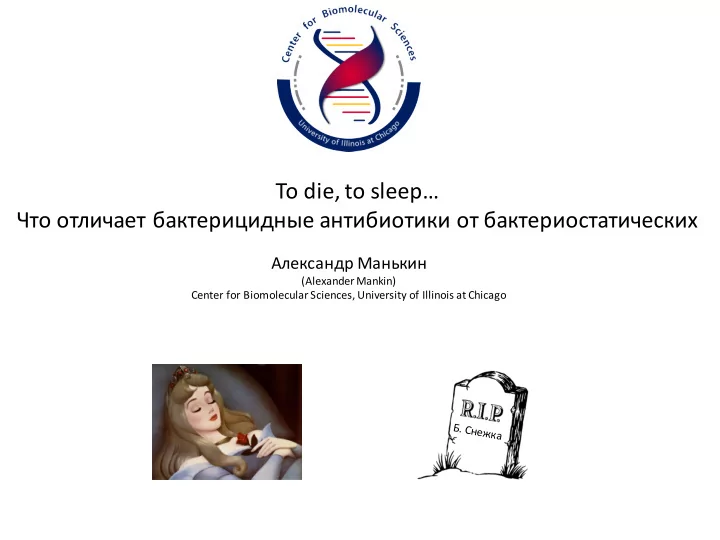

To die, to sleep… Что отличает бактерицидные антибиотики от бактериостатических Александр Манькин (Alexander Mankin) Center for Biomolecular Sciences, University of Illinois at Chicago
Ribosome is the most complex and sophisticated molecular machines in the cell
Antibiotics could be bacteriostatic or bactericidal bacteria grow antibiotic incubate plate Bacteriostatic Bactericidal Bacteriostatic drugs stop bacteria Bactericidal drugs from growing but do not kill them. kill bacteria Bacterial cells resume growth after removal of the antibiotic
The Macrolide Family O N N O N O OH HO N OH O O O O O O O O O O O O N OH O HO N O O Erythromycin Ketolides:Telithromycin (ERY) (TEL)
Catalytic center Peptide exit tunnel
Macrolides bind in the peptide exit tunnel
Common wisdom: Macrolides plug the tunnel and block synthesis of all the proteins at early rounds of translation
Macrolides act as protein- and context-specific inhibitors of translation No antibiotic TEL ERY Different macrolides inhibit synthesis of different proteins
Do different macrolides exhibit different killing activity? Streptococcus pneumoniae RNA as drug target
Surviving cells after 5 h incubation with the drugs 100.00 Tel Ery + Ery O N N 10.00 N OH HO O % survival OH O O 1.00 N O N O O O OH O O O 0.10 O N O O O OH O O OH + Tel 0.01 0 10 20 30 40 50 60 70 80 90 100 Antibiotic concentration, fold MIC Ery is static, but Tel is highly cidal
BACTERIOSTATIC BACTERICIDAL Ery Tel Sol O N N N NH 2 N N N OH HO O O OH O O O N N O O N O O O O OH O O O O O O N O O N O O OH OH O O O O OH F Erythromycin Telithromycin Solithromycin
Static ERY and cidal TEL inhibit synthesis of different proteins no drug Ery Tel
Hypothesis 1: Residual translation defines cidality
Does macrolide-induced cidality require protein synthesis? no drug x40 MIC Tet x40 MIC Tet 1000000 100000 Tetracycline + Tet 10000 CFU/mL Telithromycin 1000 100 10 0 2 4 6 8 10 12 Incubation time, hrs KILL TEST Tet Tel protein synthesis ? (static) (cidal) is required for cidality cidality does not depend of residual time translation
Tel remains bactericidal even cells could make no proteins 1000000 100000 Tet 10000 CFU/mL 1000 Tel 100 Tet Tel 10 0 2 4 6 8 10 12 Incubation time, hrs Hypothesis 1: Residual translation
Hypothesis 2: Affinity of the drug for the ribosome defines cidality
[ 14 C]-Erythromycin Ribosome Ribosome - - - - - - - - + + + ++ + DEAE magnetic beads
[ 14 C]-ERY [ 14 C]-SOL 400 400 Ribosome-bound [ 14 C]ERY, CPM Ribosome-bound [ 14 C]SOL, CPM 300 300 200 200 60 Bound/Free 60 Bound/Free 40 K D = 4.9 ± 0.6 nM K D = 5.1 ± 1.1 nM 40 20 100 100 20 0 0 0 100 200 300 0 100 200 300 Bound, CPM Bound, CPM 0 0 0 20 40 60 80 100 0 20 40 60 80 100 Concentration of added drug, nM Concentration of added drug, nM Equilibrium affinity of bactericidal SOL is comparable to the affinity of bacteriostatic ERY Hypothesis 2: Affinity of the drug for the ribosome defines cidality
k d K d = [A][B] [AB] [A] + [B] [AB] k a K d = k d / k a Drugs with similar affinities could have significantly different rates of binding and dissociation Hypothesis 3: Kinetics of the drug dissociation defines cidality
Measurement of dissociation rate [ 14 C]-ERY [ 14 C]-SOL 100 100 Ribosome-bound [ 14 C]SOL, % Ribosome-bound [ 14 C]ERY, % 80 80 60 60 40 40 20 20 0 0 0 1 2 3 4 5 6 0 1 2 3 4 5 6 24 Time, hours Time, hours Bactericidal drug dissociates very slowly from the ribosome!
Slow-dissociating drugs are bactericidal; fast-dissociating drugs are bacteriostatic Drug-free ribosome (%) Bound to the ribosome after 30 min after drug removal The slow off-rate requires an extended side-chain
Side chain makes specific contacts with the ribosome ERY TEL A752 U2609
Selection of mutants that can resist killing antibiotic incubate plate Re-grow Few surviving cells (10 -3 - 10 -4 )
Mutant cells are susceptible to solitromycin mutant: A 2058 U 100 mutant 10 Survival cells, % U 1 A 0.1 A 0.01 U wild type 0.001 0 10 20 30 40 50 60 70 80 90 100 SOL concentration, fold MIC Bactericidal Solithromycin stop mutant cells from growing but does not kill them! Most likely the dissociation of SOL from the mutant ribosomes is fast
WHY DO SLOWLY DISSOCIATING ANTIBIOTICS KILL BACTERIA?
Steady-state level of every protein is defined by the rates of synthesis and degradation Protein Growing cells Dormant cells synthesis Protein degradation synthesis synthesis degradation degradation If the dormant cell runs out of any of the key factors, translation and cell growth cannot be restarted!
Lack of any key component will prevent translation from restarting (or cell from re-growing and dividing)
drug drug dissociation from addition removal the ribosome live cells dissociation from drug drug the ribosome addition removal dead cells During prolonged period of dormancy the cell runs out of one or several critical proteins
Bacteriostatic antibiotics kill cells upon the long enough exposure Erythromycin 100 10 Survival cells, % x4 1 x10 x40 0.1 x100 0.01 0 6 12 18 24 30 36 Time, hrs
Implications: Ø Antibiotics need to be optimized not only for their affinity but also for the proper kinetics. Questions to address: Ø What is the limiting factor? Ø Could we convert bacteriostatic antibiotics into bactericidal if we inhibit the ‘limiting factor’?
Maxim Svetlov
Recommend
More recommend